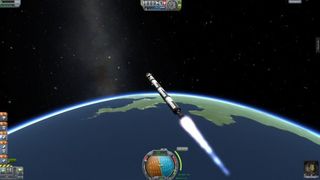Kerbal Space Program chronicle — part two: the first Kerbal in space

Liftoff looks explosion-free, so 10 kilometers up I begin my gravity turn. Wildo doesn't do anything but scream the whole way up, so it's a good thing that I'm doing the flying. Once the high point of our projected orbit, the apoapsis, reaches an altitude of 100 kilometers, I kill the engines and coast to the top of the parabola.

I didn't spend much time talking about the navball on the last mission, but it's an important instrument. The navball is the steering wheel installed on all spacecraft, and it's not as daunting as it looks. The flight team hooked me up with some post-it notes explaining the situation: orange faces down to the planet, blue faces up to space. Once in orbit, the yellow circle points in the direction of movement, the yellow X points directly behind me. To speed up (and increase distance from Kerbin), I have to burn the engines in the direction I'm already facing. To slow down (and reduce distance from Kerbin), I turn around and burn the engines in the opposite direction.

Orbiting is one of the most bizarre phenomena in physics, and I had to take a special seminar to understand it. Basically, all objects fall toward the planet they're orbiting, from poorly launched rockets to apples falling out of trees. The trick to orbiting is to be going so fast in one direction that when you fall toward Kerbin... you miss the ground.
With this in mind, at the top part of my parabola, I point to the yellow circle and burn engines, increasing my speed. Soon I'll be going so fast that the lowest part of my orbit will be roughly the same altitude as the highest, and that will give Wildo Kerman a nice, circular orbit.
The biggest gaming news, reviews and hardware deals
Keep up to date with the most important stories and the best deals, as picked by the PC Gamer team.
Most Popular


